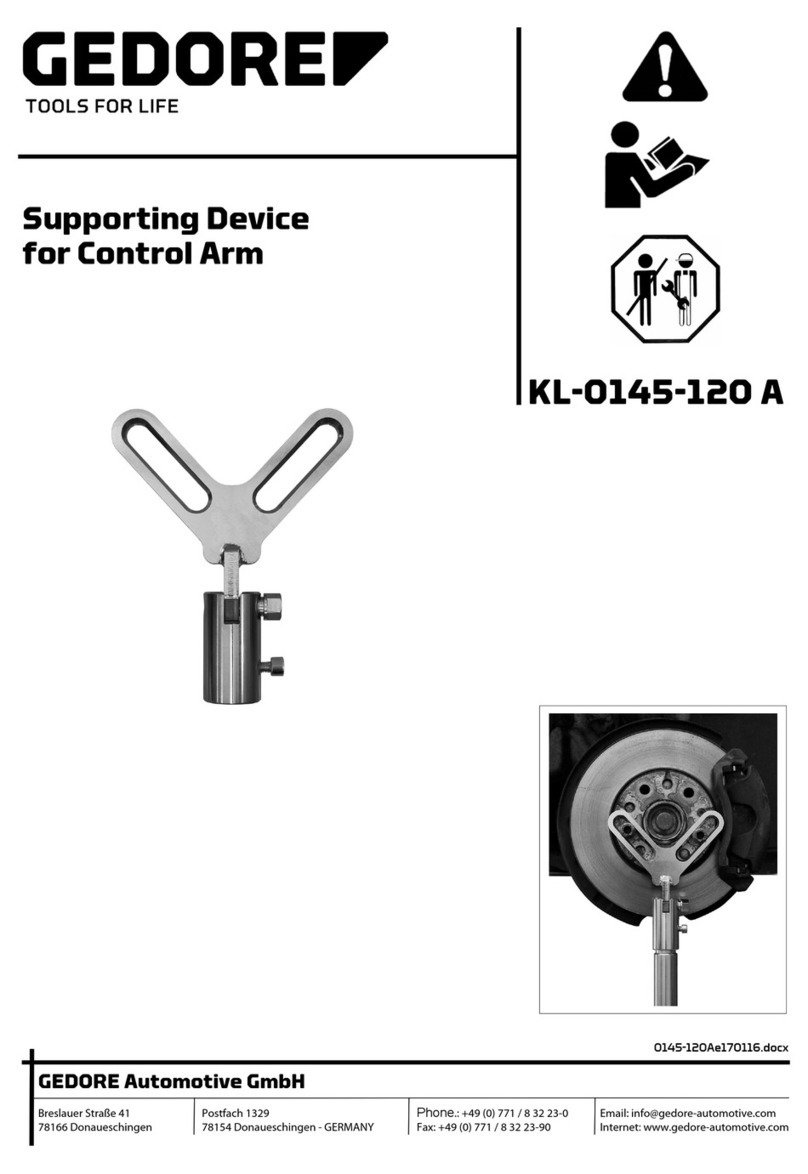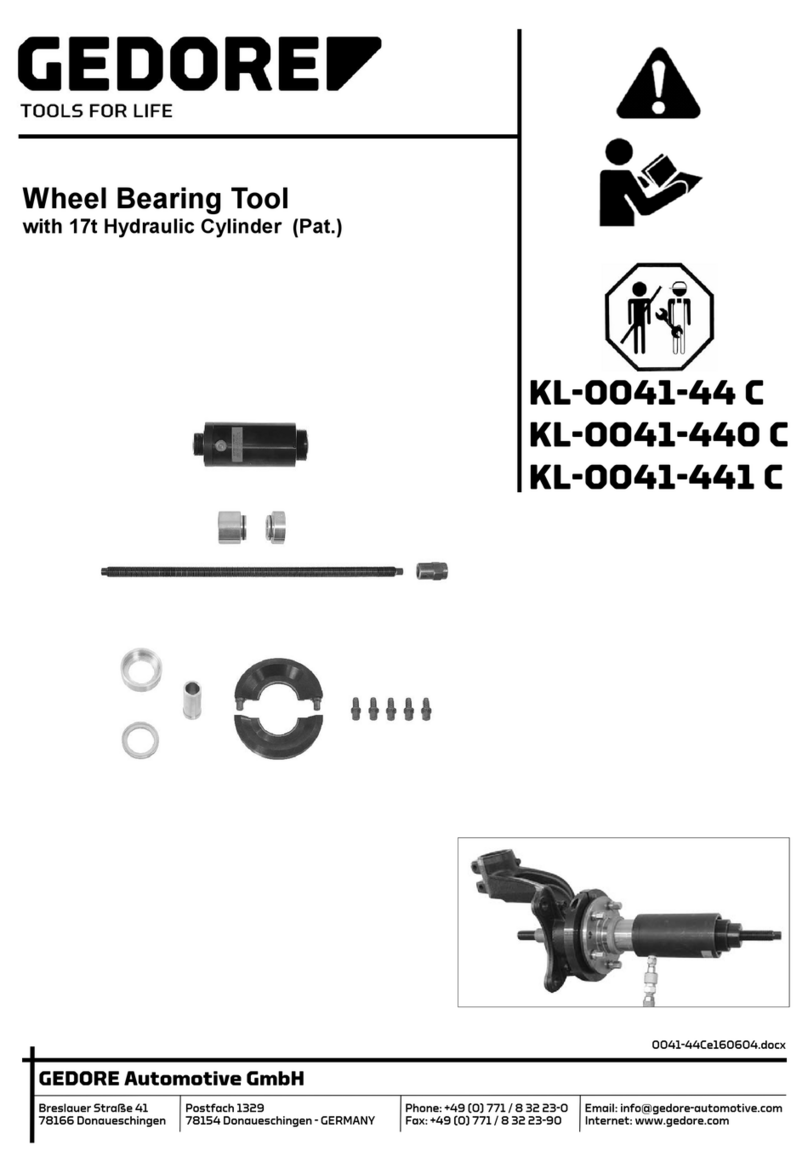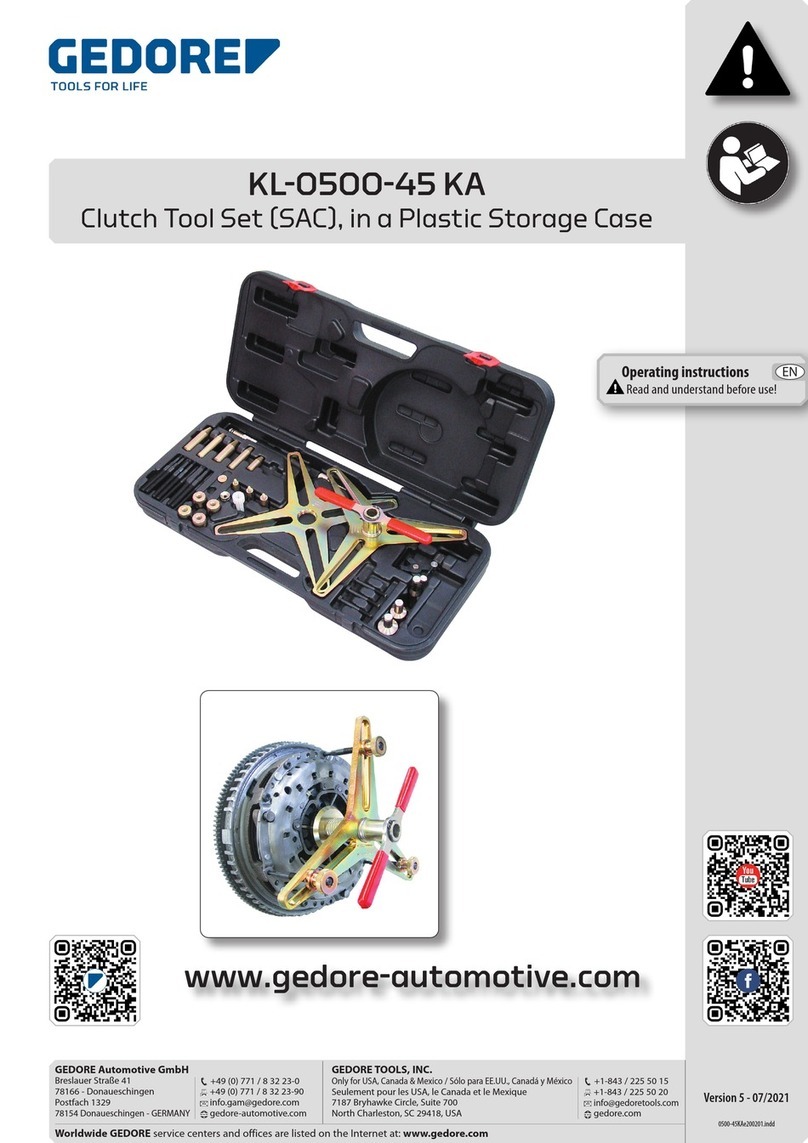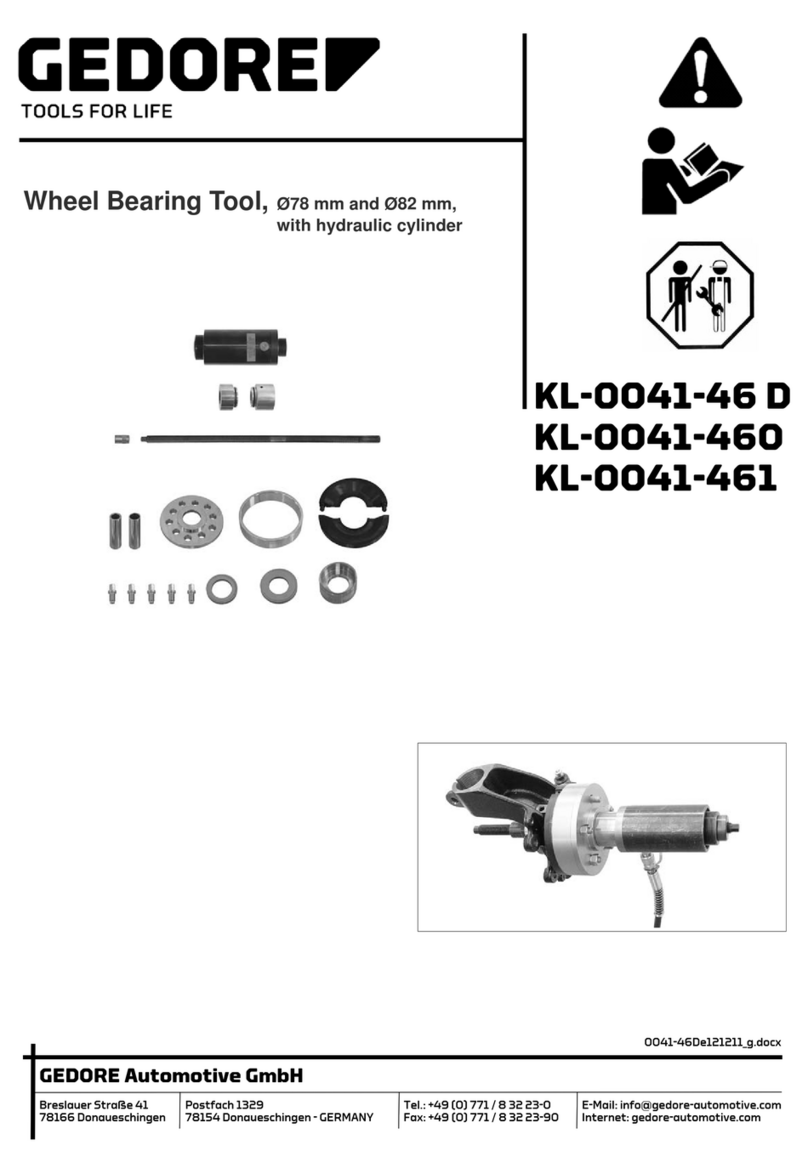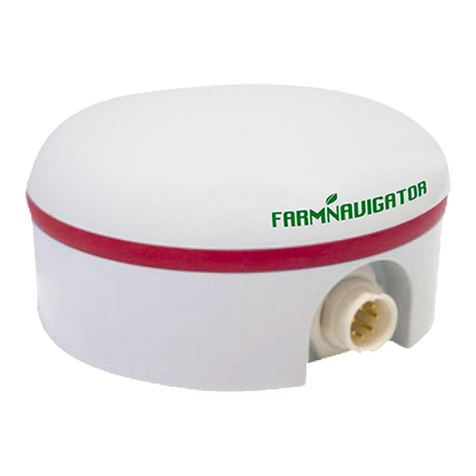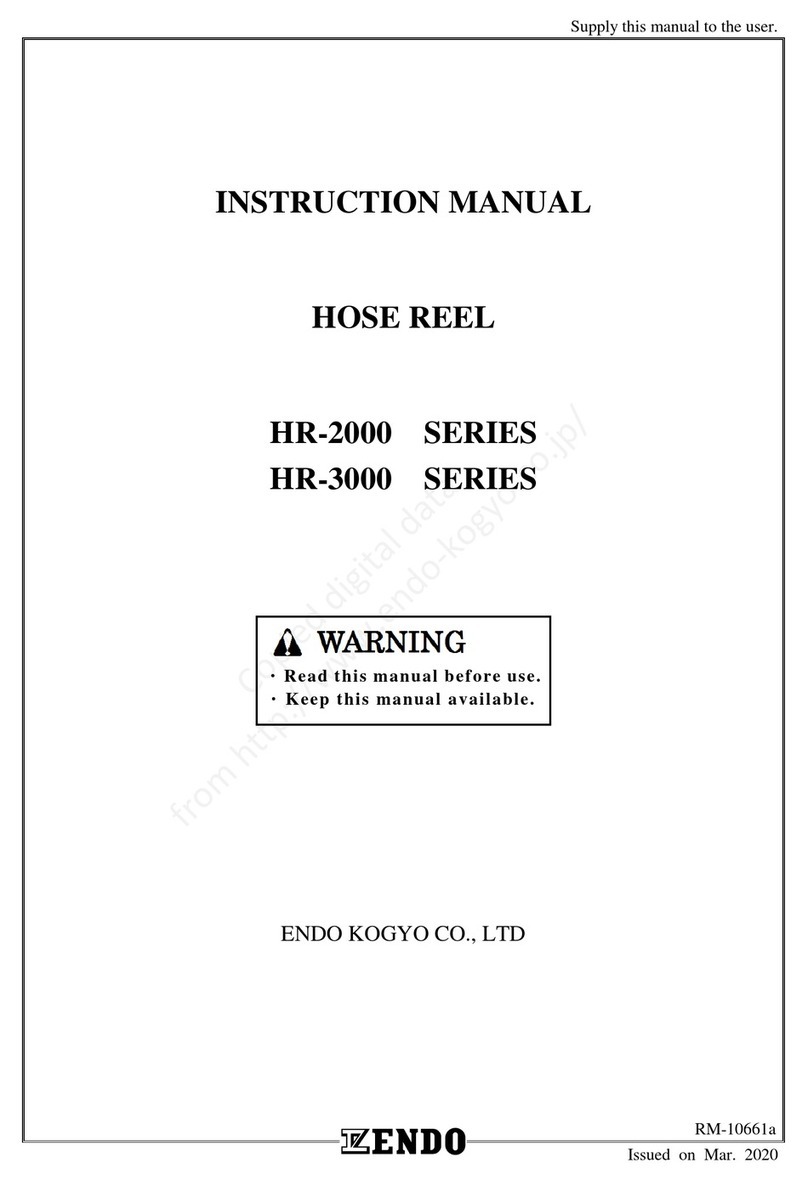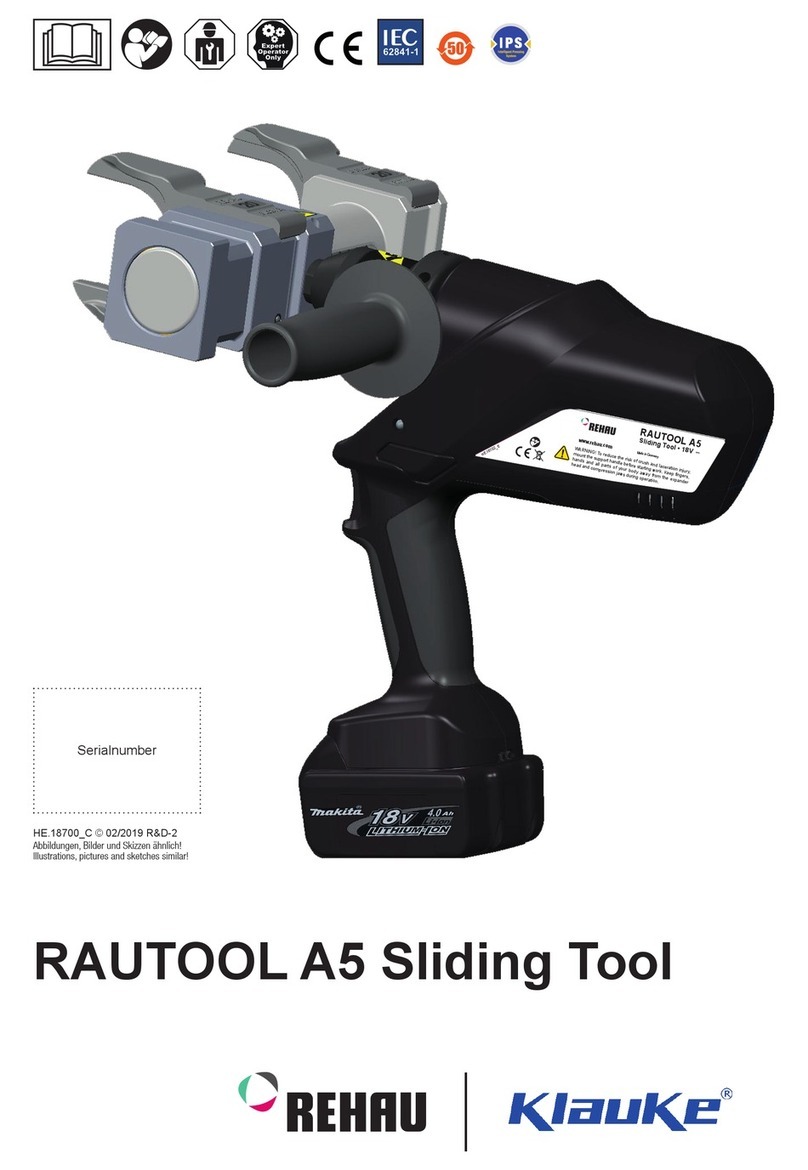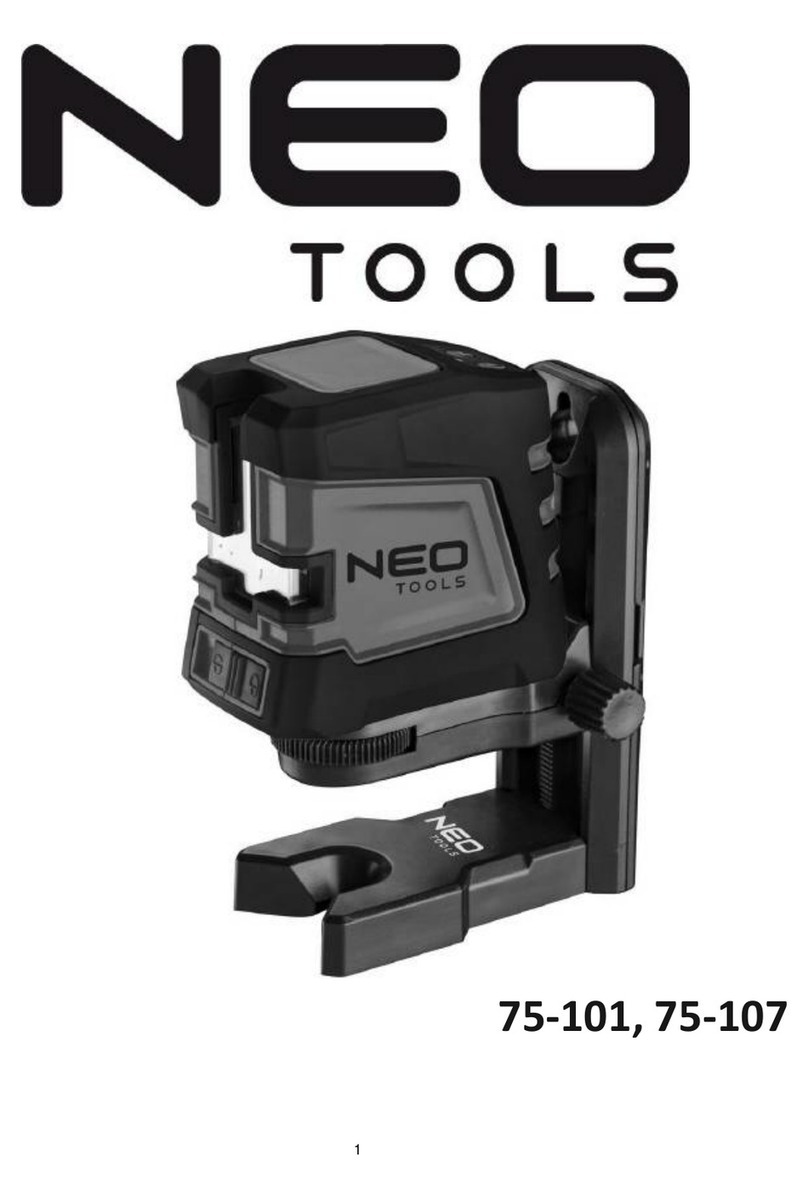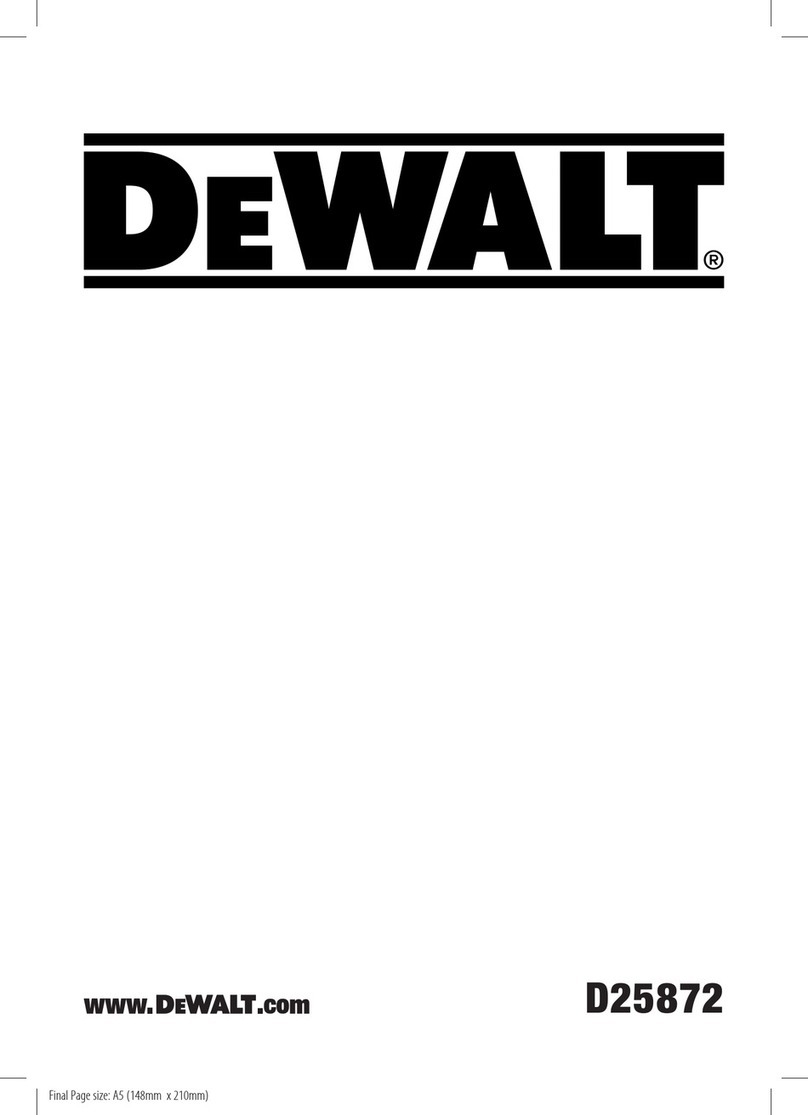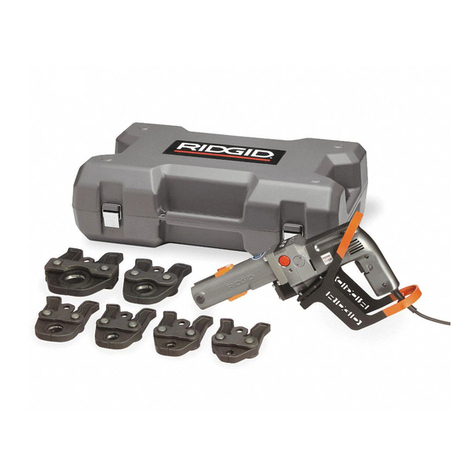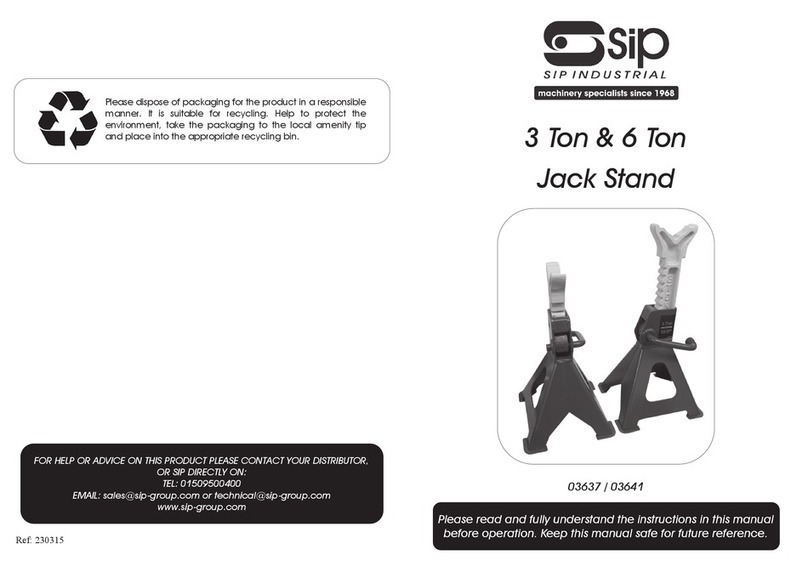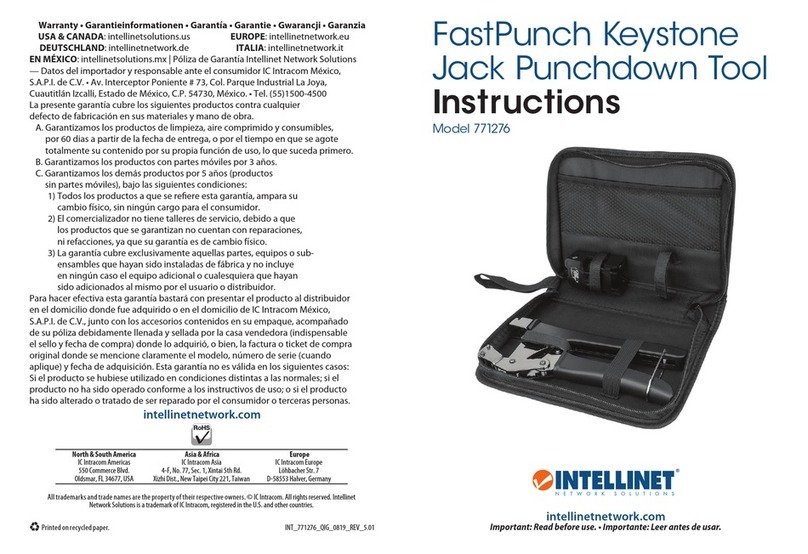Gedore KL-2000 User manual

GEDORE WELTWEIT / GEDORE WORLDWIDE
Weltweite GEDORE Servicestellen / Niederlassungen finden Sie im Internet unter: www.gedore.com
Worldwide GEDORE service centers / offices are listed on the Internet at: www.gedore.com
GEDORE Automotive GmbH
Breslauer Straße 41
78166 - Donaueschingen
Postfach 1329
78154 Donaueschingen - GERMANY
T +49 (0) 771 / 8 32 23-0
F +49 (0) 771 / 8 32 23-90
www.gedore-automotive.com
GEDORE TOOLS, INC.
Only for USA, Canada & Mexico
Sólo para EE.UU., Canadá y México
Seulement pour les USA, le Canada et le Mexique
7187 Bryhawke Circle, Suite 700
North Charleston, SC 29418, USA
Phone +1-843 / 225 50 15
Fax +1-843 / 225 50 20
info@gedoretools.com
04/2019
www.gedore-automotive.com
2000SPe160713.docx
K
L
-2000
KL-2000 SP
Spring Compressor

2000SPe160713.docx ©Copyright by GEDORE Automotive GmbH, German
y
21
Instruction Manual EN
English
2 - 24
Impressum
Im Zuge der Verbesserung und Anpassung an den Stand der Technik behalten wir uns Änderungen im Hinblick auf Aussehen, Abmessungen, Gewichte und Eigenschaften sowie
Leistungen vor.
Damit ist kein Anspruch auf Korrektur oder Nachlieferung bereits gelieferter Produkte verbunden. Streichungen können jederzeit vorgenommen werden, ohne dass ein rechtlicher
Anspruch entsteht.
Alle Hinweise zur Benutzung und Sicherheit sind unverbindlich. Sie ersetzen keinesfalls irgendwelche gesetzlichen oder berufsgenossenschaftlichen Vorschriften.
Für Druckfehler übernehmen wir keine Haftung.
Ein Nachdruck, auch auszugsweise, bedarf der vorherigen schriftlichen Zustimmung durch GEDORE Automotive GmbH.
Alle Rechte weltweit vorbehalten.
Wir verweisen auf unsere Allgemeinen Geschäftsbedingungen, ersichtlich im Impressum unter www.gedore-automotive.com.
© Copyright by GEDORE Automotive GmbH Donaueschingen (GERMANY)
Impressum/Legal Notice
As part of our commitment to continuous product improvement and adaptation to state-of-the art technology, we reserve the right to make modifications to our products with
regard to design, dimension, weight, features and performances at any time and without prior notice.
Thus, the right to adjustments or replacement deliveries of goods already delivered is excluded. Cuts and cancellations can be made by us at any time without notice and no legal
claims against us may arise or be derived from this.
All indications regarding use and safety are given for information only and without any commitment. In no case do they substitute for legal provisions or the regulations of the
Employer’s Liability Insurance Association.
Errors and omissions excepted.
Any reproduction, also in extracts, is subject to the prior written consent of GEDORE Automotive GmbH.
All rights reserved.
We refer to our General Terms and Conditions of Sale under ‘Imprint’ at www.gedore-automotive.com.
© Copyright by GEDORE Automotive GmbH Donaueschingen (GERMANY)
Impressum/Mentions légales
En raison des améliorations continues que nous apportons à nos produits et pour assurer leur adaptation constante à l'évolution des techniques, nous nous réservons le droit de
procéder à des modifications de nos produits quant à l’apparence, aux dimensions, aux poids, aux caractéristiques et aux performances à tout moment sanspréavis et sans obligation
de modifier ou de remplacer des produits précédemment livrés.
Des suppressions peuvent être effectuées à tout moment et sans préavis sans qu’elles puissent donner lieu à réclamation.
Toutes les instructions d’utilisation et conseils de sécurité sont donnés sans engagement de notre part. Ils ne se substituent en aucun cas aux réglementations légales en vigueur
ou à celles émises par les associations professionnelles.
Le plus grand soin possible a été apporté à la rédaction de ce document. Toutefois, nous n’assumons aucune responsabilité pour des erreurs, omissions ou défauts d’impression
éventuels.
Une reproduction, même en partie, ne peut être effectuée qu’après autorisation écrite préalable de GEDORE Automotive GmbH.
Tous droits réservés.
Vous trouverez nos conditions générales de vente, sous Impressum/Mentions légales sur www.gedore-automotive.com.
© Copyright by GEDORE Automotive GmbH Donaueschingen (GERMANY)

2000SPe160713.docx
©Copyright by GEDORE Automotive GmbH, Germany 3
1
Instruction Manual EN
Table of Contents
Page
1. Essential Safety Notices .............................................................................................................. 4
1.1 Safety Notices and Warnings............................................................................................................................ 4
1.2 Personal Protective Equipment........................................................................................................................ 4
1.3 Intended Use.......................................................................................................................................................... 5
1.4 Safe and Proper Use............................................................................................................................................ 5
1.5 Work Environment ............................................................................................................................................... 5
1.6 Appropriate Users................................................................................................................................................ 5
2. Product Description ..................................................................................................................... 6
2.1 KL-2000 SP - Spring Compressor.................................................................................................................... 6
2.2 Technical Data....................................................................................................................................................... 7
3. Checking the Delivery/Assembling the Spring Compressor.................................................... 7
3.1 Scope of Delivery (Fig. 2) ........................................................................................................................7
3.2 Identifying and Choosing the Appropriate Jaws. .................................................................................7
3.3 Mounting the Jaws on Compressor Base Body. ..................................................................................8
4. Removing and Installing a Spring............................................................................................... 9
4.1 Clamping a Suspension-/Damper Strut into the holding fixture.............................................................. 9
4.2 Removing a Spring .............................................................................................................................................. 9
Technique 1: Removing a spring using the jaws that engage the spring coils. ................................... 9
Technique 2: Removing a spring using the special jaws that encompass the upper spring plate.12
4.3 Installing a Spring .............................................................................................................................................. 15
Technique 1: Installing a spring using the jaws that engage the spring coils.................................... 15
Technique 2: Installing a spring using the special jaws that encompass the upper spring plate . 18
5. Inserting the Drive Nut Shear Pin.............................................................................................. 21
6. Care and Storage........................................................................................................................ 21
7. Accessories................................................................................................................................. 21
8. Maintenance and Repair by the GEDORE Automotive Service Centre ................................. 23
9. Spare Parts List KL-2000 SP ...................................................................................................... 23
10. Environmentally Safe Disposal............................................................................................... 24

2000SPe160713.docx ©Copyright by GEDORE Automotive GmbH, German
y
41
Instruction Manual EN
1. Essential Safety Notices
Before using the spring compressor, it is imperative that you read and understand the Instruction Manual. Misuse can lead to
SERIOUS INJURIES and even DEATH.
This Instruction Manual is part of the spring compressor. Keep the Instruction Manual in a safe place for future reference and
pass it on to subsequent users of the spring compressor.
All vehicle-specific data stated herein are supplied under reserve and without commitment.
1.1 Safety Notices and Warnings
For better differentiation, the warning notices in this Instruction Manual are classified as follows:
Warning
sign Sign reads Meaning
DANGER Indicates a hazardous situation which, if not avoided, may result in serious or fatal injuries.
ATTENTION Indicates a situation which, if not avoided, may result in damage to the spring compressor or
its functioning, or to objects in its vicinity.
DANGER
Do not exceed the maximum load capacity of the spring compressor, otherwise there is a risk that it could fail/break and
debris/broken parts becoming projectiles.
ATTENTION
Risk of damage to vehicle and tool.
Lubricate spindles with molybdenum disulphide paste KL-0014-0030 (accessory).
Any work on vehicles should only be performed by qualified specialist personnel observing and complying with the directions,
provisions, and safety regulations specified by the vehicle manufacturer.
Always refer to the vehicle manufacturer’s data and instructions as only these apply to all work that is carried out on the
vehicle.
1.2 Personal Protective Equipment
ALWAYS wear personal protective equipment when using the spring compressor. The spring compressor can cause mechanical
hazards leading to injuries such as contusions, cuts or concussions.
EYE PROTECTION (see OSHA 29 CFR 1910.133 and ANSI Z87) designed to protect you from flying debris/objects
must be worn when using the spring compressor.
Particles may be ejected at very high speed while working with the spring compressor and could cause serious
injuries to your eyes.
SAFETY GLOVES must be worn when using the spring compressor.
Working with the spring compressor can cause skin abrasions and contusions.
SAFETY SHOES/BOOTS with slip resistant soles and steel-toe caps (see OSHA 29 CFR 1910.136 and ANSI 241)
must be worn when using the spring compressor.
Falling parts can cause serious injuries to feet and toes.

2000SPe160713.docx
©Copyright by GEDORE Automotive GmbH, Germany 5
1
Instruction Manual EN
1.3 Intended Use
The spring compressor is only designed to compress the right-hand wound coil springs that are found in passenger car
chassis systems.
The spring compressor may only be used in the manner as described in this Instruction Manual.
The spring compressor may only be used in specialised professional passenger car workshops/garages.
The spring compressor must only be used for compressing MacPherson-type suspension/damper struts up to a maximum
load of 8 500 N.
Any other use can result in severe injuries or even death.
1.4 Safe and Proper Use
Take the following safety precautions to prevent injuries and damage that could be caused by improper handling or unsafe use
of the spring compressor.
Misuse can result in extremely severe injuries or even death.
NEVER overload the spring compressor.
ALWAYS check the spring compressor prior to EACH use in order to ensure that it is in good order and condition.
ALWAYS replace all damaged and worn parts prior to using the spring compressor.
ONLY use the original spare parts and accessories from GEDORE Automotive on the spring compressor.
1.5 Work Environment
For safety reasons, work with the spring compressor should only be carried out in a safe and secure work environment.
The workplace should always be clean and tidy.
The workplace should be sufficiently large and must be secured.
1.6 Appropriate Users
This Instruction Manual is designed for technicians in workshops.
DO NOT allow children to use the spring compressor.
Purchasers/employers purchasing the spring compressor MUST ensure that any person/employee using the spring compressor
have read and understood this Instruction Manual prior to using the tool. This Instruction Manual MUST be made available to the
users of the spring compressor for reference at all times.

2000SPe160713.docx ©Copyright by GEDORE Automotive GmbH, German
y
61
Instruction Manual EN
2. Product Description
2.1 KL-2000 SP - Spring Compressor
Field of Application
The KL-2000 SP spring compressor comes with the pairs of jaws KL-1510 SP (size 1N) and KL-1520 SP (size 2N) equipped with protective inserts,
thus allowing the user to professionally remove/install right-hand wound coil springs (with a spring Ø of 70-240mm*) and shock absorbers on
passenger car chassis systems.
*in conjunction with jaws available as accessories.
Note: The KL-2000 Spring Compressor is like the KL-2000 SP, but comes without the protective inserts.
Cylinder tube
Drive nut
Fixed jaw mount
Jaw with protective
insert
Hex bolt, M5x45mm
Hex nut, M5
Mobile jaw mount/slide
Spindle
Jaw with protective
insert
Hex bolt, M5x45mm

2000SPe160713.docx
©Copyright by GEDORE Automotive GmbH, Germany 7
1
Instruction Manual EN
2.2 Technical Data
Dimensions:
Overall length 410mm
Working travel (stroke) 245mm
Min. opening (distance between jaws): 45mm
Max. opening (distance between jaws): 290mm
Load capacities:
Maximum load capacity:............................................ 8 500 N
Breaking point: ........................................................ 32 000 N
Weight:
Compressor base body: ................................................ 4.8kg
Compressor base body with jaws size 1N and 2N: ....... 8.6kg
Drive: ................................................................... waf 24mm
Spring Ø
(min / max)
:.................................................80-195mm
3. Checking the Delivery/Assembling the
Spring Compressor
Before the first commissioning of the spring compressor, check
and confirm you have all the parts listed in the scope of delivery.
Then, read and follow the mounting instructions.
3.1 Scope of Delivery (Fig. 2)
- Compressor base body
- Pair of jaws with protective inserts, size 1N
- Pair of jaws with protective inserts, size 2N
3.2 Identifying and Choosing the Appropriate Jaws.
DANGER
Considerable forces are exerted when springs are being
compressed. Never use jaws that do not fit properly as there is
a risk of the coil spring coming loose and falling off or being
ejected from the spring compressor during the compression
process.
1. Choose the suitable jaws. (Fig. 3 A).
Note: The correct jaws can also be identifed manually.
2. Determine the suitable jaws on the basis of the following
criteria:
- Spring diameter (Fig. 3 B)
- Spring pitch (Fig. 3 C)
Fig. 1: Dimensions.
KL-2000-100 Compressor base body
Fig. 2: Checking the Delivery.
Fig. 3: Identifying and choosing the appropriate jaws.
“B“ “C“
Identify spring Ø
Identify spring pitch
“A“
Pair of jaws with
protective inserts, size 2N
Compressor base body
Pair of jaws with
protective inserts, size 1N

2000SPe160713.docx ©Copyright by GEDORE Automotive GmbH, German
y
81
Instruction Manual EN
3. The identified jaw must comply with the following criteria:
- suitable for right-hand wound coil springs,
- suitable to allow the spring to be accurately seated in the
jaw (in diameter and in pitch), (Fig. 4 A),
- suitable to allow the safety lip to engage behind the spring.
(Fig. 4 B).
- In the event of compressing conical springs, use the
KL-1590-1 adaptor (accessory) along with a jaw to
compensate for the distance to the base body in order to
ensure that the longitudinal axis of the spring and of the
base body are parallel to each other (in true alignment).
(see Fig. 4 C)
Note: On some vehicles, compressing the spring is only
possible with the aid of specially designed jaws (see
accessories).
3.3 Mounting the Jaws to Compressor Base Body.
DANGER
Considerable forces are exerted when springs are being
compressed. If the jaws are not properly mounted and
fixed/secured with the specified hex bolts/nuts, there is a risk
that the spring compressor could fail and break into pieces.
This will lead to debris/parts or the spring becoming
projectiles.
Always check to ensure that the profiles of the jaws fit
accurately into the profiles of the jaw mounts on the base
body. If using the adaptor, also make sure it is correctly
engaged in the jaw/jaw mount. Secure with the hex bolts
and nuts.
Assemble spring compressor with the suitable pair of jaws.
Mount jaws to spring compressor as shown in
Fig. 5 A and B; secure with hex bolts and nuts.
When compressing conical springs, additionally use the
KL-1590-1 adaptor (accessory), secure with hex bolts and
nuts. (Fig. 6 A, B, C and D)
Fig. 4: Suitable jaw identified.
Fig. 5: Mounting the jaws to base body
(applies to standard springs).
Fig. 6: Mounting the jaws to base body
(applies to conical springs).
3
Spring compressor
ready for use.
“C“
Mount jaw to
fixed jaw mount.
“A“
Mount jaw to
mobile jaw mount.
“B“
4
Safety lip
“C“
Adaptor
“A“
“B“
Spring
compressor
ready for use
Mount jaw
with adaptor
to fixed jaw
mount.
Mount jaw to
mobile jaw
mount.
KL-1590-1 Ada
p
tor for conical s
p
rin
g
s
Compressing
a conical
spring
“A“ “B“ “C“ “D“
KL-1590-1
Adaptor

2000SPe160713.docx
©Copyright by GEDORE Automotive GmbH, Germany 9
1
Instruction Manual EN
4. Removing and Installing a Spring
The following instructions describe the procedure of removing/installing
a right-hand wound coil spring from/to a suspension-/damper strut.
The examples show two different techniques which are to be applied
depending on the type of jaws used. (Fig. 7)
Technique 1: Removing and installing a spring using the jaws that
engage the spring coils.
Technique 2: Removing and installing a spring using the special jaw
that encompasses the upper spring plate.
Note: Compressing a rear axle spring on the vehicle can be carried out
according to the same principle as described in technique 1. The
procedure is similar, however, with the difference that
dismantling/reassembling the suspension/damper strut is not necessary.
During the whole compression and decompression processes, pay
attention to the space available. Make sure that the base body and the
jaws do not touch the vehicle/car body parts, and that they are not
pushed against these.
DANGER
Considerable forces are exerted when springs are being compressed.
Strictly adhere to the following instructions. Non-observance can lead to
hazardous situations such as breakage of the spring compressor
resulting in debris/parts or the spring becoming projectiles.
Never use the spring compressor if it is damaged or defective.
Never use a hammer on the tool.
Lubricate the spindle with molybdenum disulphide paste, for example
KL-0014-0030.
Only use molybdenum disulphide paste, for example KL-0014-0030,
as lubricant.
Only use Original GEDORE Automotive spare parts.
ATTENTION
Stop turning the drive nut once the spring compressor has reached its
limit stop (that is when the mobile jaw mount has been slid against the
fixed one until limit stop). Failure to do so will result in damage to the
spring compressor.
Once the spring compressor has reached its limit stop, that is when
the mobile jaw mount has been slid against the fixed one until limit
stop, make sure that the drive nut is rotated only in the opposite
direction.
Note: Always perform all work on the vehicle/vehicle components in
strict compliance with the directions, provisions, and safety regulations
specified by the vehicle manufacturer.
4.1 Clamping a Suspension-/Damper Strut
into the holding fixture.
DANGER
Suspension-/damper struts that are not properly fixed can come
loose and fall off the spring compressor while the spring is being
compressed.
Do not clamp neither the suspension-/damper strut nor the spring
compressor into a vice.
Clamp the removed suspension-/damper strut into holding fixture
KL-0055-60 (accessory). (See Fig. 8)
4.2 Removing a Spring
Technique 1: Removing a spring using the jaws that
engage the spring coils.
1.
ATTENTION
When opening the jaws, there is a risk of damage to the base body.
When opening the jaws on the base body, make sure that there is
no pressure being exerted on the limit stop once the maximum
opening distance has been reached.
(Stop turning the drive nut counter-clockwise.)
Using a 1/2" reversible ratchet with a 24mm (waf) socket, turn the
drive nut and adjust the spring compressor so as to enable it to grasp
and compress as many coils as possible. (Fig. 9)
Fig. 7: Compressing a spring.
Technique 1: Technique 2:
Compressing a spring Compressing a spring via
via the spring coils. the upper spring plate.
Fig. 8: Clamping the suspension-/damper strut into
holding fixture.
Removing a Spring (Technique 1)
Fig. 9: Preadjusting the spring compressor.
(see Fig. 16)
KL-0055-60
Holding Fixture (Accessory)

2000SPe160713.docx ©Copyright by GEDORE Automotive GmbH, German
y
10 1
Instruction Manual EN
2.
DANGER
Make sure that the spring compressor is correctly positioned,
otherwise there is a risk of the coil spring coming loose and
falling off or being ejected from the spring compressor during
the compression process.
The spring must be accurately seated in the jaws (in
diameter and in pitch). (See Fig. 4 A)
The safety lip must engage behind the spring. (See
Fig. 4 B)
In the event of compressing conical springs, use the
KL-1590-1 adaptor (accessory) along with a jaw to
compensate for the distance to the base body in order to
ensure that the longitudinal axis of the spring and of the
base body are parallel to each other (in true alignment).
(See Fig. 4 C)
Apply spring compressor against spring.
(see Fig. 10 A and B).
3.
DANGER
The maximum load capacity of the spring compressor must
not be exceeded, otherwise there is a risk that the tool could
fail and break into pieces. This will lead to debris/parts
becoming projectiles.
At the latest, stop compressing the spring once the
minimum opening distance has been reached - that is
when the mobile jaw mount touches the fixed jaw mount -
but in any case before the spring coils touch each other.
To compress the spring, turn the drive nut clockwise (as
shown in Fig. 11) using a 1/2" reversible ratchet with a 24mm
(waf) socket. Compress the spring until the pressure on the
piston rod nut has been completely relieved. (Fig.
12 A, B and C)
Note:
If it is not possible to compress the spring in such a
manner that there is no longer any pressure on the piston
rod nut, the compression process must be aborted. In this
case, the spring cannot be removed.
Fig. 10: Applying the spring compressor against the spring.
Fig. 11: Compressing the spring.
Fig. 12: Compressing the spring until pressure on piston
rod nut is fully released.
X > 0
X
“B“ “C“
STOP!
Before spring is coil-
bound.
STOP!
Spring is loose
on the strut.
STOP!
Piston is completely
retracted into cylinder.
“A“

2000SPe160713.docx
©Copyright by GEDORE Automotive GmbH, Germany 11
1
Instruction Manual EN
4. Loosen piston rod nut, for example by means of the
KL-0056-100 K tool set. Remove strut mount and upper
spring plate. (Fig. 13 A and B)
5. Remove compressed spring along with spring compressor
from suspension strut. (Fig. 13 C)
6. Use paint to mark the positions of the jaws on the spring.
(Fig. 14)
7. ATTENTION
When decompressing the spring, there is a risk of damage
to the jaws.
When decompressing the spring, make sure that the jaws
with their outer face do not touch the spring.
When decompressing the spring, there is the risk of
damage to the base body.
When decompressing the spring, make sure that there is
no pressure being exerted on the limit stop once the
maximum opening distance on the base body has been
reached.
(Stop turning the drive nut counter-clockwise.)
To decompress the spring, turn the drive nut counter-
clockwise using a 1/2" reversible ratchet with a 24mm (waf)
socket (Fig. 15 A) until the jaws do no longer touch the
spring. Stop the decompression process as soon as the
maximum opening distance of 290mm has been reached.
Note: If it is not possible to release, respectively, open the
spring compressor far enough so that the jaws are no longer
in contact with the spring and the latter can be removed, the
decompression process must be aborted. In this case, the
spring needs to be compressed again and the suspension-
/damper strut must be reassembled according to the
manufacturer's instructions.
Changing the spring is not possible.
8. Remove spring compressor from spring.
(Fig. 15 B)
Fig. 13: Removing the compressed spring.
Fig. 14: Marking the positions of the jaws.
Fig. 15: Decompressing the spring.
“B“
“A“ “C“
“A“
“B“
Mark

2000SPe160713.docx ©Copyright by GEDORE Automotive GmbH, German
y
12 1
Instruction Manual EN
Technique 2: Removing a spring using the special
jaw that encompasses the upper spring plate.
1.
ATTENTION
When opening the jaws, there is a risk of damage to the base
body.
When opening the jaws on the base body, make sure that
there is no pressure being exerted on the limit stop once
the maximum opening distance has been reached.
(Stop turning the drive nut counter-clockwise.)
Using a 1/2" reversible ratchet with a 24mm (waf) socket,
turn the drive nut and adjust the spring compressor so as to
enable it to grasp and compress as many coils as possible.
2.
DANGER
Make sure that the spring compressor is positioned correctly,
otherwise there is a risk of the coil spring coming loose and
falling off or being ejected from the spring compressor during
the compression process.
Be sure that the spring is accurately seated in the jaws (in
diameter and in pitch). (See Fig. 4 A)
The safety lip must engage behind the spring.
(See Fig. 4 B)
In the event of compressing conical springs, use the
KL-1590-1 adaptor (accessory) along with a jaw to
compensate for the distance to the base body in order to
ensure that the longitudinal axis of the spring and of the
base body are parallel to each other (in true alignment).
(See Fig. 4 C)
Apply spring compressor against spring.
(See Fig. 16).
Note: The plastic adaptor rings of the ring jaws are specially
adapted to the shape of the respective upper spring plates.
When positioning the ring jaw on the suspension-/damper
strut, make sure that it fits properly the shape of the spring
plate.
Removing a Spring (Technique 2)
Fig. 16: Applying the spring compressor
against the spring.
Compressing a spring via the upper spring plate.
Compressing a spring: Peugeot 206.

2000SPe160713.docx
©Copyright by GEDORE Automotive GmbH, Germany 13
1
Instruction Manual EN
3.
DANGER
The maximum load capacity of the spring compressor must
not be exceeded (see technical data), otherwise there is a
risk that the tool could fail and break into pieces. This will
lead to debris/parts becoming projectiles.
At the latest, stop compressing the spring once the
minimum opening distance has been reached - that is
when the mobile jaw mount touches the fixed jaw mount -
but in any case before the spring coils touch each other
.
To compress the spring, turn the drive nut clockwise using a
1/2" reversible ratchet with a 24mm (waf) socket as shown
in Fig. 17. Compress the spring until the pressure on the
piston rod nut has been completely relieved.
Note:
If it is not possible to compress the spring until there is no
longer any pressure on the piston rod nut, the
compression process must be aborted. In this case, the
spring cannot be removed.
4. Loosen piston rod nut; for example, by means of the
KL-0056-100 K tool set (accessory). (Fig. 18)
Fig. 17: Compressing the spring.
Fig. 18: Loosening the piston rod nut.
X > 0
X
“B“

2000SPe160713.docx ©Copyright by GEDORE Automotive GmbH, German
y
14 1
Instruction Manual EN
5. Remove strut mount and upper spring plate. (Fig. 19 A)
Remove compressed spring along with spring compressor
from strut. (Fig.19 B)
6. Use paint to mark the positions of the jaws on the spring.
(Fig. 20)
7. ATTENTION
When decompressing the spring, there is a risk of damage
to the base body.
When decompressing the spring, make sure that there is
no pressure being exerted on the limit stop once the
maximum opening distance on the base body has been
reached.
(Stop turning the drive nut counter-clockwise.)
To decompress the spring, turn the drive nut counter-
clockwise using a 1/2" reversible ratchet with a 24mm (waf)
socket until the jaws do no longer touch the spring. (Fig. 21)
Stop the decompression process as soon as the maximum
opening distance of 290mm has been reached.
Note: If it is not possible to release, respectively open, the
spring compressor far enough so that the jaws are no longer
in contact with the spring and the latter can be removed, the
decompression process must be aborted. In this case, the
suspension-/damper strut needs to be reassembled
according to the manufacturer's instructions. Changing the
spring is not possible.
8. Remove spring compressor from spring.
Fig. 19: Removing the compressed spring.
Fig. 20: Marking the position of the jaws.
Fig. 21: Decompressing the spring.
Mark
“B““A“

2000SPe160713.docx
©Copyright by GEDORE Automotive GmbH, Germany 15
1
Instruction Manual EN
4.3 Installing a Spring
Technique 1: Installing a spring using the jaws that
engage the spring coils.
1. Using a 1/2" reversible ratchet with a 24mm (waf) socket,
turn the drive nut and adjust the spring compressor so that
the jaws can be positioned on the spring at exactly the same
place as they were when the spring was removed. (Fig. 22)
Note: If a new spring is used, remember to copy the marks
for positioning the jaws from the old spring to the new one.
2. DANGER
Make sure that the spring compressor is positioned correctly,
otherwise there is a risk of the coil spring coming loose and
falling off or being ejected from the spring compressor during
the compression process.
Be sure that the spring is accurately seated in the jaws (in
diameter and in pitch). (See Fig. 4 A)
The safety lip must engage behind the spring. (See Fig. 4 B)
In the event of compressing conical springs, use the
KL-1590-1 adaptor (accessory) along with a jaw to
compensate for the distance to the base body in order to
ensure that the longitudinal axis of the spring and of the
base body are parallel to each other (in true alignment).
(See Fig. 4 C)
Apply spring compressor against spring at exactly the same
position as it was when the spring was removed. (Fig. 23)
3. Using a 1/2" reversible ratchet with a 24mm (waf) socket,
turn the drive nut clockwise until the jaws with their clamping
surface properly fit the spring. (Fig. 24)
Installing a Spring (Technique 1)
Fig. 22: Preadjusting the spring compressor.
Fig. 23: Applying the spring compressor against spring.
Fig. 24: Spring compressor applied against spring.
Mark

2000SPe160713.docx ©Copyright by GEDORE Automotive GmbH, German
y
16 1
Instruction Manual EN
4.
DANGER
The maximum load capacity of the spring compressor must
not be exceeded (see technical data), otherwise there is a
risk that the tool could fail and break into pieces. This will
lead to debris/parts becoming projectiles.
At the latest, stop compressing the spring once the
minimum opening distance has been reached, that is when
the mobile jaw mount touches the fixed jaw mount, but in
any case before the spring coils touch each other.
To compress the spring, turn the drive nut clockwise using a
1/2" reversible ratchet with a 24mm (waf) socket, as shown
in Fig. 25.
5. Stop the compression process as soon as the upper spring
plate and strut mount can be placed on the piston rod.
(Fig. 27)
Place spring compressor along with spring onto suspension-
/damper strut.
Note: When assembling the suspension-/damper strut,
make sure that the piston rod has been extended completely.
Pull out the piston rod if necessary.
Fig. 25: Compressing the spring.
Fig. 26: Spring compressed.
Fig. 27: Positioning the spring on
the suspension/damper strut.
X > 0
X

2000SPe160713.docx
©Copyright by GEDORE Automotive GmbH, Germany 17
1
Instruction Manual EN
6. Assemble suspension strut according to the manufacturer's
instructions. Make sure that spring is correctly seated.
(Fig. 28)
7. ATTENTION
When decompressing the spring, there is a risk of damage
to the jaws.
When decompressing the spring, make sure that the jaws
with their outer face do not touch the spring.
To decompress the spring, turn the drive nut counter-
clockwise using a 1/2" reversible ratchet with a 24mm (waf)
socket until the jaws do no longer touch the spring (Fig. 29).
Note: Make sure that the spring is correctly seated in the
lower and upper spring plate.
8. Remove spring compressor from spring. (Fig. 30)
Fig. 28: Assembling the suspension strut.
Fig. 29: Decompressing the spring.
Fig. 30: Removing the spring compressor from spring.

2000SPe160713.docx ©Copyright by GEDORE Automotive GmbH, German
y
18 1
Instruction Manual EN
Technique 2: Installing a spring using the special jaw
that encompasses the upper spring plate.
1. Using a 1/2" reversible ratchet with a 24mm (waf) socket,
turn the drive nut and adjust the spring compressor so that
the jaws can be applied against the spring at exactly the
same position as when the spring was removed. (Fig. 31)
Note: If a new spring is used, remember to copy the marks
for positioning the jaws from the old spring to the new one.
2.
DANGER
Make sure that the spring compressor is positioned correctly,
otherwise there is a risk of the coil spring coming loose and
falling off or being ejected from the spring compressor during
the compression process.
Be sure that the spring is accurately seated in the jaws (in
diameter and in pitch). (See Fig. 4 A)
The safety lip must engage behind the spring.
(See Fig. 4 B)
In the event of compressing conical springs, use the
KL-1590-1 adaptor (accessory) along with a jaw to
compensate for the distance to the base body in order to
ensure that the longitudinal axis of the spring and of the
base body are parallel to each other (in true alignment).
(See Fig. 4 C)
Apply spring compressor against spring at exactly the same
position as when the spring was removed. (Fig. 32)
3. To pre-compress the spring, turn the drive nut clockwise
using a 1/2" reversible ratchet with a 24mm (waf) socket.
Pre-compress approximately 10cm.
4. Place spring compressor along with spring onto suspension-
/damper strut.
Note: When assembling the suspension-/damper strut,
make sure that the piston rod has been completely extended.
Pull out the piston rod if necessary.
Installing a Spring (Technique 2)
Fig. 31: Preadjusting the spring compressor.
Fig. 32: Applying the spring compressor against spring.
Fig. 33: Spring compressor applied against spring.
Mark

2000SPe160713.docx
©Copyright by GEDORE Automotive GmbH, Germany 19
1
Instruction Manual EN
5.
DANGER
The maximum load capacity of the spring compressor must
not be exceeded (see technical data), otherwise there is a
risk that the tool could fail and break into pieces. This will
lead to debris/parts becoming projectiles.
At the latest, stop compressing the spring once the
minimum opening distance has been reached - that is
when the mobile jaw mount touches the fixed jaw mount -
but in any case before the spring coils touch each other.
To compress the spring, turn the drive nut clockwise using a
1/2" reversible ratchet with a 24mm (waf) socket, as shown
in Fig. 34.
Note: The spring compressor features an auxiliary drive.
Fig. 34: Compressing the spring.
Fig. 35: Spring compressed.
X > 0
X

2000SPe160713.docx ©Copyright by GEDORE Automotive GmbH, German
y
20 1
Instruction Manual EN
6. Stop the compression process as soon as the strut mount
can be placed onto the piston rod. (Fig. 36)
Note: Be sure that the piston rod is completely extended.
7. Assemble suspension strut according to manufacturer's
instructions. Make sure that spring is correctly seated.
(Fig. 37)
8. ATTENTION
When decompressing the spring, there is a risk of damage
to the jaws.
When decompressing the spring, make sure that the jaws
with their outer face do not touch the spring.
To decompress the spring, turn the drive nut counter-
clockwise using a 1/2" reversible ratchet with a 24mm (waf)
socket until the jaws do no longer touch the spring. (Fig. 38).
Note: Make sure that the spring is correctly seated in the
lower and upper spring plate.
9. Remove spring compressor from spring.
Fig. 36: Positioning the spring
on suspension-/damper strut.
Fig. 37: Assembling the suspension strut.
Fig. 38: Decompressing the spring.
“A“ “B“
This manual suits for next models
1
Table of contents
Other Gedore Tools manuals
Popular Tools manuals by other brands

EGAmaster
EGAmaster 56066 operating instructions
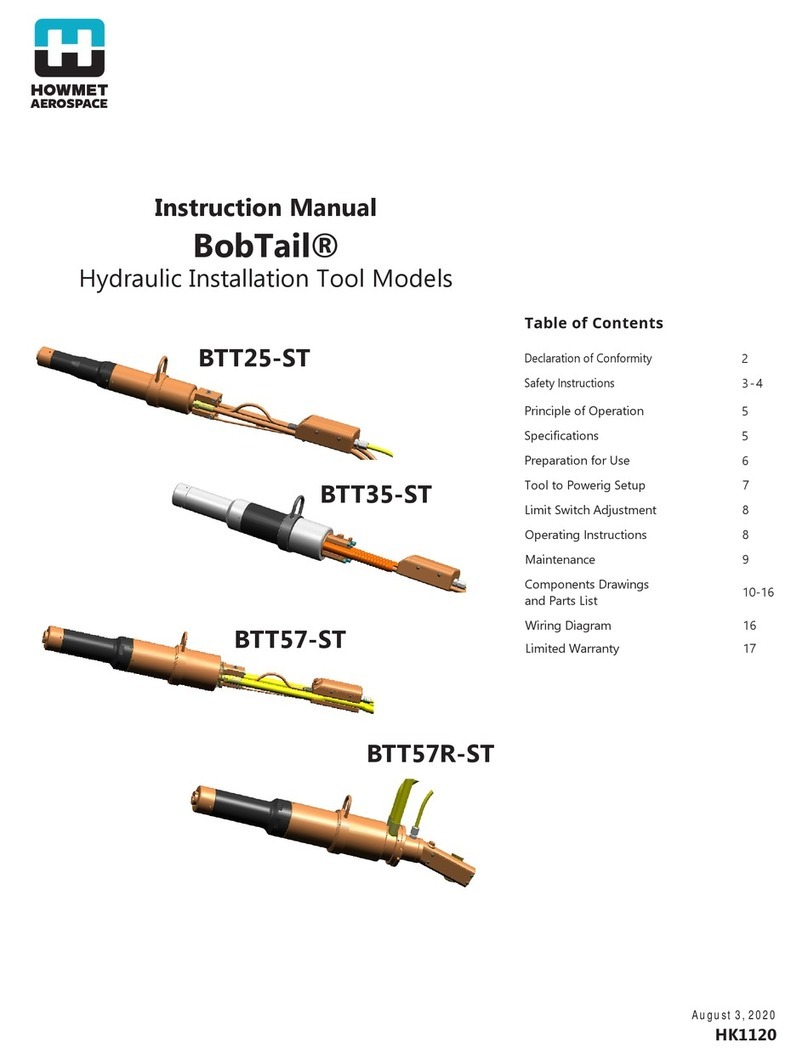
Howmet Aerospace
Howmet Aerospace BobTail BTT25-ST instruction manual
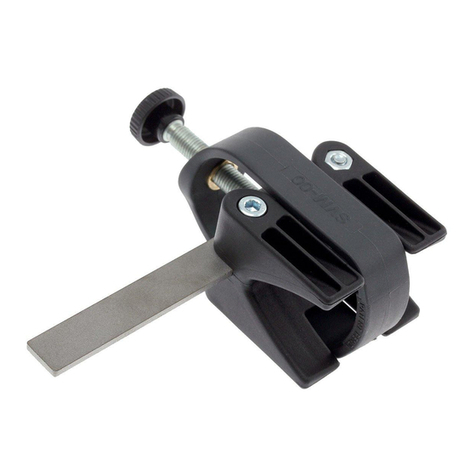
tormek
tormek SVM-00 instructions
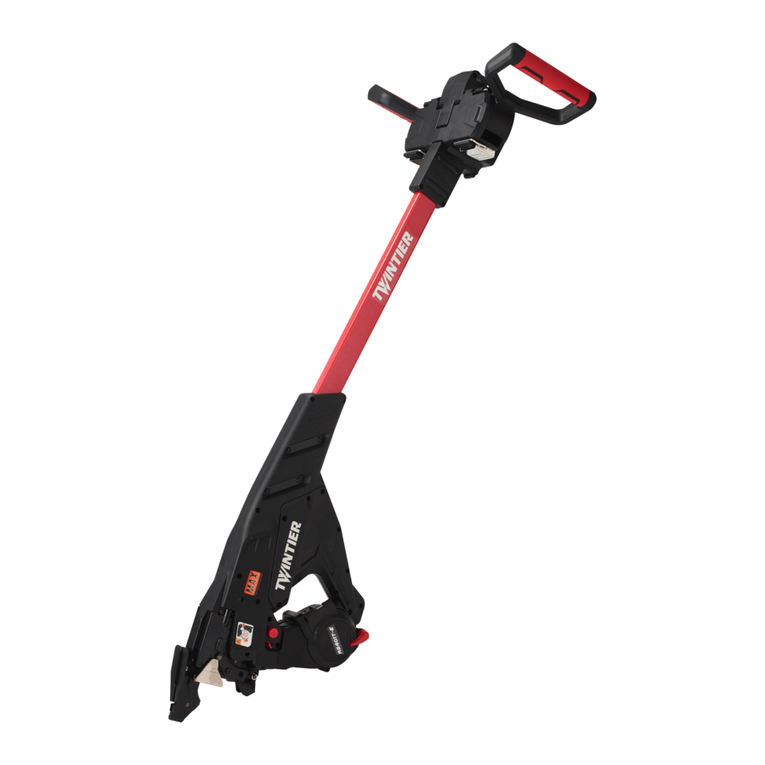
Max
Max ReBar Tier Twintier RB401T-E Instruction manual and safety instructions
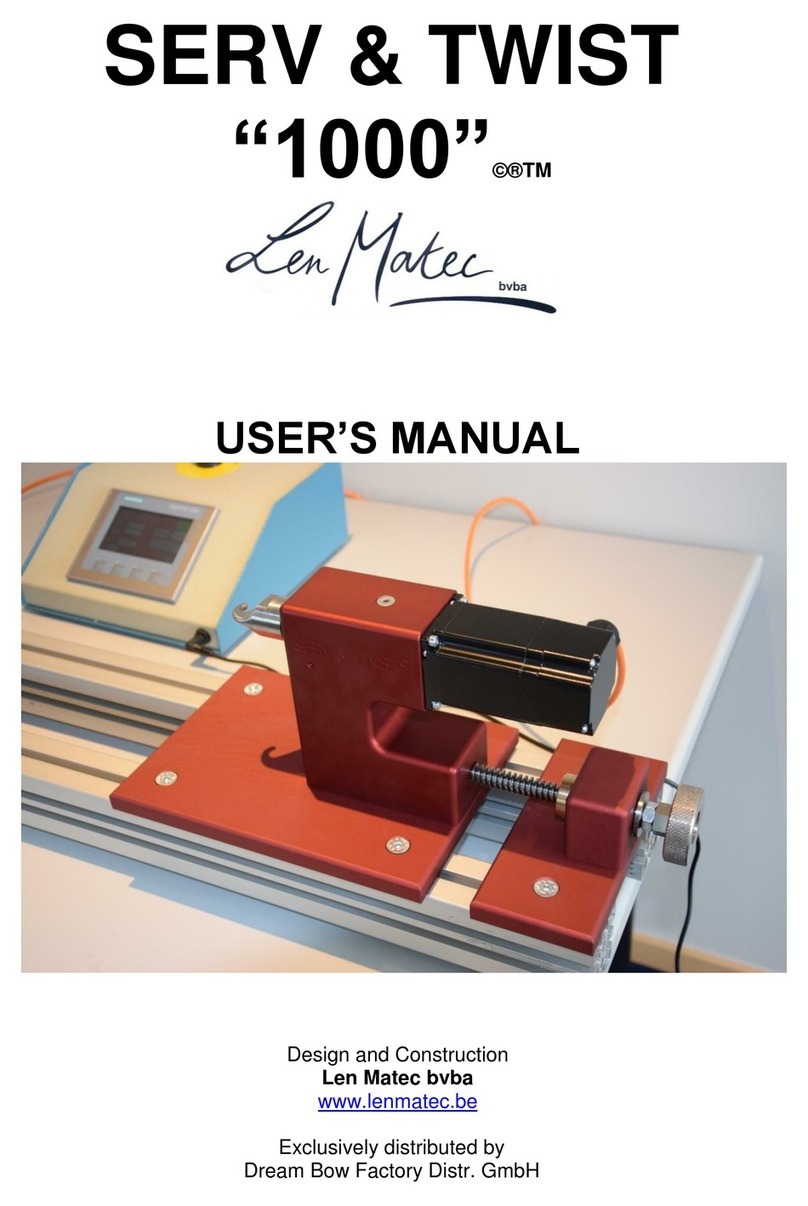
Len Matec
Len Matec SERV & TWIST 1000 user manual
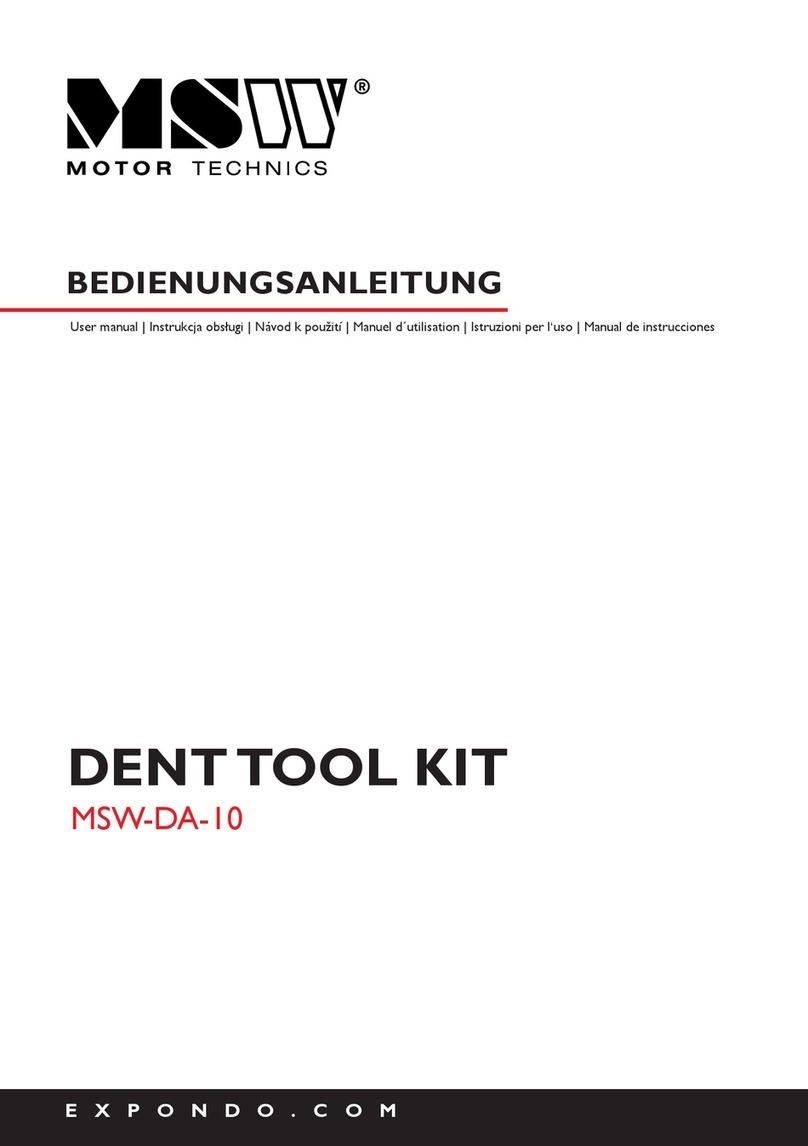
MSW
MSW MSW-DA-10 user manual


